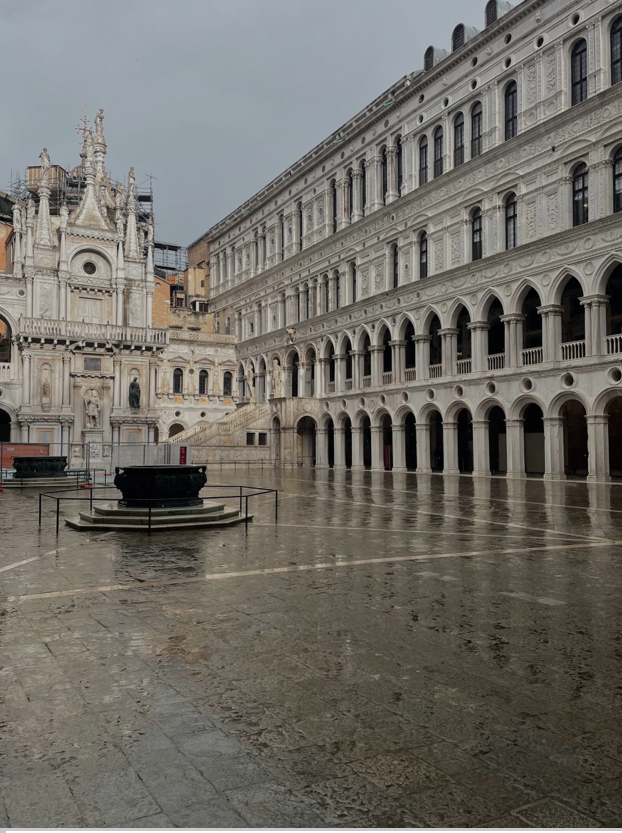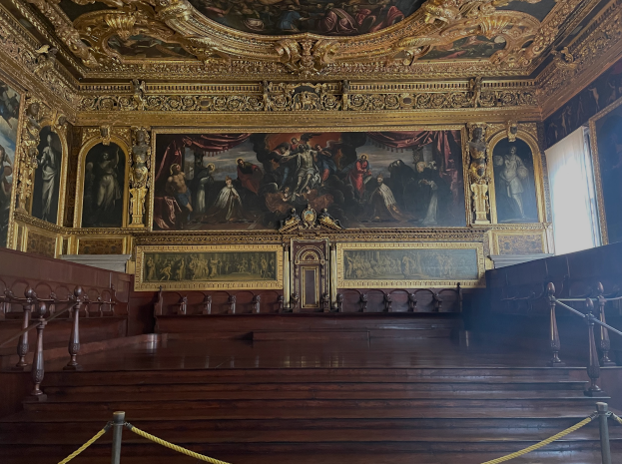Exploring the Doge’s Palace: Jan Term in Italy
By Gwen Brantner, '26

The Doge’s Palace is a significant landmark of Venice, Italy, and is located in St. Mark’s square. The palace was used as the residence of the Doge of Venice, who was the highest authority in the old Venetian Republic. As Venice grew into a more busy and powerful center of trade, they gained wealth and expanded their government, creating the need for a new governmental palace.
The earlier architecture in Venice primarily followed the Byzantine style. Shown in the appearance of St. Mark’s Basilica, built next to the palace, this style was very intricate in its patterns and colorful mosaics. The Doge’s Palace, however, combines this with the Gothic style which was becoming popular throughout Europe at the time. This creates a new style unique to Venice. During construction, stucco was used instead of marble because of the weight of marble. Marble is too heavy for a city that is on the water and slowly sinking.
Originally, construction of the palace began around 1340 BC, but there were many changes to the layout and architecture following multiple fires and other choices by different Doges throughout the years of construction. The outside remained very impressive-looking through these changes, because this was the first place that people came to in Venice, as well as where they would meet with the Doge or other government officials. The appearance, outside and inside, is a visual representation of the power the Doge had. They used a lot of gold flanked adornments to decorate, covered almost every wall in a painting, and filled the ceilings and other areas with magnificent sculptures.
The Venetian Republic was a unique system of government combining monarchy through the Doge, aristocracy through the Senate, and a republic of Rialto families in the Great Council. This also meant there was a unique separation from the church in the system itself, although the proximity between St. Mark’s Basilica and the Palace suggests they still got along and supported each other. This is unique compared to other parts of Italy, where either the church ran the government, or the two pieces did not get along, leading to disagreements, separations, or a fight for power, as seen in the formation of Vatican City.

The history of the Palace was very noticeable when moving through the building. At first, when we walked in, we saw the impressive courtyard positioned between the Basilica and the Palace. This made the actual connection of the two buildings apparent, something very unique from the rest of Italy, where church and state did not get along so well. Following this, we made our way up many stairs, another demonstration of the Doge’s power. Guests to the palace would have had to climb these stairs and make their way through a few very grand and impressive rooms before getting to see the Doge himself. This put the Doge physically above those coming into the palace, and the path through the rooms gave the opportunity for the Doge to show off his assets, paintings, or other things that showed off his power and wealth.
The throne room was incredibly and intricately decorated, the walls and ceilings covered in paintings and statues with lots of gold decorations around them. The area where the throne would have been was raised and there were more steps to get up to the throne, again placing the Doge in a physically higher position than those coming in. It was clear throughout our visit that the palace was laid out and constructed in a way to emphasize the power of the Doge.
Following the throne room we walked into the armory. This was the most unique part of the Doge’s Palace, compared to other locations we had been in Italy. Most other places we went on this trip had paintings, statues, mosaics, and lots of religious pieces, not armor or weapons. This was one of our favorite parts because it was really interesting to see all the old weapons and armor that they would have used while defending the city many years ago. Some of the weapons were also very well taken care of and maintained to reflect their original condition as well as possible.
Lastly, we got to go into the dungeons and see where the prisoners would have been kept, which was interesting because they were somewhat hidden in a lower part through very narrow halls. This again reflected representative construction of the Palace. The Doge was the highest, followed by the Great Council one level down, and then the lowest were the prisoners. We really got to see the full history of the Palace through all of these rooms. The educational descriptions provided in many of the rooms made it easy to understand the context and function of each room. While the art and grand, gold-adorned rooms were very beautiful, the weapons and dungeons also made it easy to realize the reality of the Palace’s history and world history in general. It isn’t all pretty and gold like shown in the churches and museums. Overall, going to Doge’s Palace was a great experience because of how unique and informational it was about the history of Venice.
